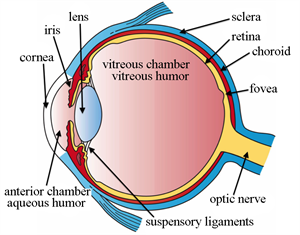PDF chapter test TRY NOW
Sunlight - White or Coloured:

Passing white light through a prism
-
We tend to think of sunlight as being white in colour, but it is not. VIBGYOR is a collection of seven colours (violet, indigo, blue, green, yellow, orange and red). All of these colours combine to create white light.
-
When sunlight passes through some optical devices, such as a prism, it splits into seven component colours. The splitting of light into its constituents is referred to as 'dispersion of light.'

Dispersion of white light
Structure of the human eye:

Human eye- structure
- We see the objects around us only when the light from the object enters our eyes. so it is important to study the structure and working of our eyes.
- The eye has a spherical structure which is called the eyeballs. The eyeballs are attached to the eye socket, and various muscles are connected to them called the eye muscles. These are muscles allow the movement of the eyeballs.
- Eyes are protected with eyelids. They prevent an excess of light and dust from entering the eyes, saving the eyes from any outer objects.
- The transparent front part of the eye is called the cornea; behind the cornea, there is a dark, muscular structure called the iris.
- There is a small opening in the iris called pupil. The function of the iris is to control the amount of light that enters the eyes.
- A lens that is thicker in the centre is present behind the pupil. We studied that a lens that is thicker at the centre is called a convex lens.
- The lens focuses light on the back of the eye, on a layer called the retina.
- The retina acts as a screen; thus, the image of the object is formed on the retina. The retina contains several nerve cells that transmit the sensations to the brain through the optic nerve. There are two kinds of cells.
Rod cells: They are sensitive to dim light.
Cone cells: They are sensitive to bright light.
Blindspot:
The junction of the optic nerve and the retina has no sensory cells, so no vision is possible at the spot. This spot is called a blind spot.
- The image formed on the retina does not vanish suddenly; it persists for 1/16th of a second.
- Thus, if still images of moving objects are flashed on the eye at a rate faster than 16 per second, then our eye perceives that the object is moving.
- In animation movies, separate pictures are arranged in a proper sequence. They are made to move at a rate greater than 16 per second. Then our eye perceives that the object is moving.
Reference:
https://commons.wikimedia.org/wiki/File:Three_Main_Layers_of_the_Eye.png
https://commons.wikimedia.org/wiki/File:Dispersions.png
